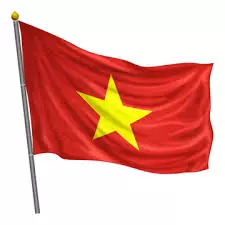OF CABBAGES AND KINGS | Vietnam vignettes: How a Communist country celebrates its entrepreneurs | Farrukh Dhondy
Hanoi, a city of a hundred lakes, has an island in the centre called Banana Island. No marks for guessing what it grows!

“When Passion governs reason and the mind
The Passionate will inevitably find
Themselves adrift.
Some emotions defy the truth and cause
Reason and common sense to pause
And can then shift
The self-inflicted victim to hurt and pain
When all is lost there’s certainly no gain
--No going back!
No reason then can reassert the truth
Repair the damage from resentment’s tooth --
Alas! Alack!”
From The Hand of Baiganbertha
In Vietnam’s sunny clime,
Where I’m spending a little time
Absorbing food, its museums and its ways --
-- and though however short
This observed brief report,
Can’t say much -- that would take a thousand days!
(apologies to Gunga Din’s rhythm?)
My first observation in this gentle, attractive country: Hanoi, a city of a hundred lakes, has an island in the centre called Banana Island. No marks for guessing what it grows! The island has no electric supply, but on the bamboo-and-banana-leaf-thatched peasant huts, there are solar panels connected to car batteries which store energy for nights and stoves. A unique example of late technology surpassing the need for the earlier?
In the slums of the city, reminiscent of alleys in Pune and Naples, people hang out their washing on balcony parapets, using solar power instead of tumble-dryers to dry their washing. Older technology trumping the more recent?
Apart from reminding me of other cities with their clothes-hanging balconies, Hanoi has a very distinctive look. Even though there are very many other sorts of buildings here, in parts of Hanoi built during French colonial occupation, a sort of “window-tax” regulated the width of ground floor buildings on a terraced street. The breadth was/is the size of a truck’s garage door and the terraced buildings, in various architectural patterns, varied oblong boxes, rise from these or even smaller widths. They rise to maybe eight floors with the ground floor being strictly commercial accommodation.
Apart from the common universal architecture of the contemporary world, there are also classical French buildings like the Opera House and the Presidential Palace in Ho Chi Minh City.
Adorning every city are flags, some with a yellow sickle and hammer over red and others with a yellow five-pointed star, the national flag of Vietnam. The five points of the star symbolise or stand for peasants, workers, soldiers, “intellectuals” and “entrepreneurs”. Did I get that last group wrong?
“Entrepreneurs” symbolised by the flag of a “Communist” country? I suppose Marx did say that capitalism was revolutionary in its progression from and expulsion of feudalism, though exploitation of the working class was twinned with its development.
The Communist symbol, of the sickle for the farmer and the hammer for the worker, could in Vietnam be expanded to include a pen for the intellectual, a sword or pistol for the soldier and for the entrepreneur…??? What? A balaclava to symbolise the “all property is theft” slogan? A spiked whip to symbolise the persuasion used on the workers to yield surplus value to Capital? … Gentle reader, it’s a competition, so do suggest what best symbolises the class function of entrepreneurs?
Does my impression of Vietnam tell me it’s a “Communist” country? It is certainly and absolutely obsessed with its population’s heroic struggle against American imperial intrusion -- from the time the US supplied arms to the French in the war which the French lost at Dien Bien Phu, to the mid-1970s, when under Lyndon Johnson’s and Richard Nixon’s presidencies the Americans were defeated by Ho Chi Minh’s forces and, after the cruellest war using napalm, bombardment and torture, had to admit defeat and FO.
The museums of Vietnam’s cities are almost exclusively dedicated to commemoration of this heroism and this war. Even one floor of the Museum of Vietnamese Women called “Women Through Vietnam’s History” has no exhibits of women in any era before the American war in the 1950s t0 1975. Nothing about women in the earlier centuries. Female heroines and their stories and testimony during THE WAR are the “history of Vietnamese women”.
Another floor of the same museum is devoted to the religious practices and rituals of birth, marriage and the naming of babies. The dominant religions, Buddhism and Taoism, have temples and pagodas devoted to them all over the country and there are no moves to do anything but celebrate these faiths and diversity.
So: entrepreneurs; freedom of religion; very particular and pointed patriotism (which includes a sincere appreciation of the Americans who opposed the war and that of other nations supporting Vietnam against the US invasion); chaotic traffic; policemen reputedly rich from bribes; no free multi-party elections; the ordinary citizen without a huge, provable bank account not being able to leave the country and being subjected to prohibitive bureaucracy….
“Communism” has not yet invaded the earth’s nations, whatever the term in our contemporary world would mean for the organisation of society.
I think I’d call what I have, so cursorily, witnessed on a short trip to Vietnam, a kind of “socialism”, though it would only be one definition of even that widely abused word.
Russia? China? Cuba? Venezuela? Communist??? Socialist??? Dictatorially controlled Capitalism?
As Alice, in our Blunderland, would ask: “The question is, can you make one word mean so many different things?”
And no doubt Humpty Dumpty would answer: “The question is: ‘Who is to be Master, that is all!’”
